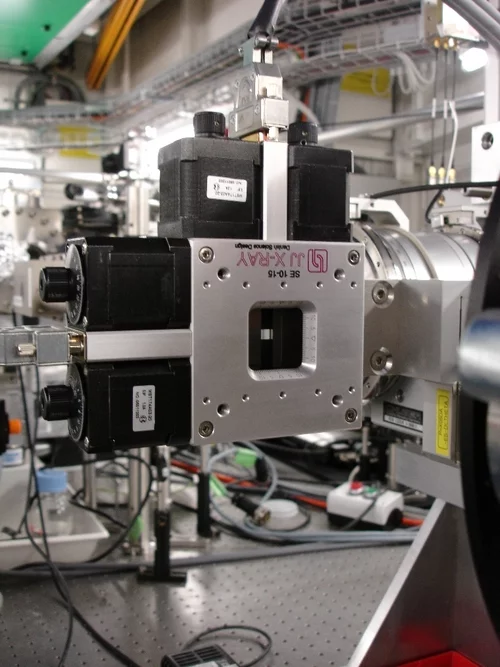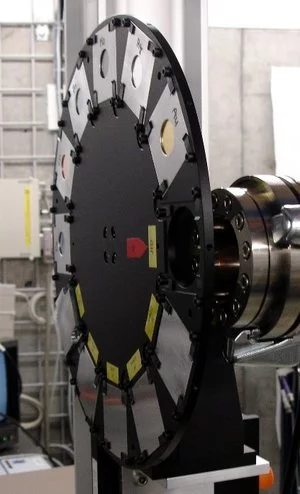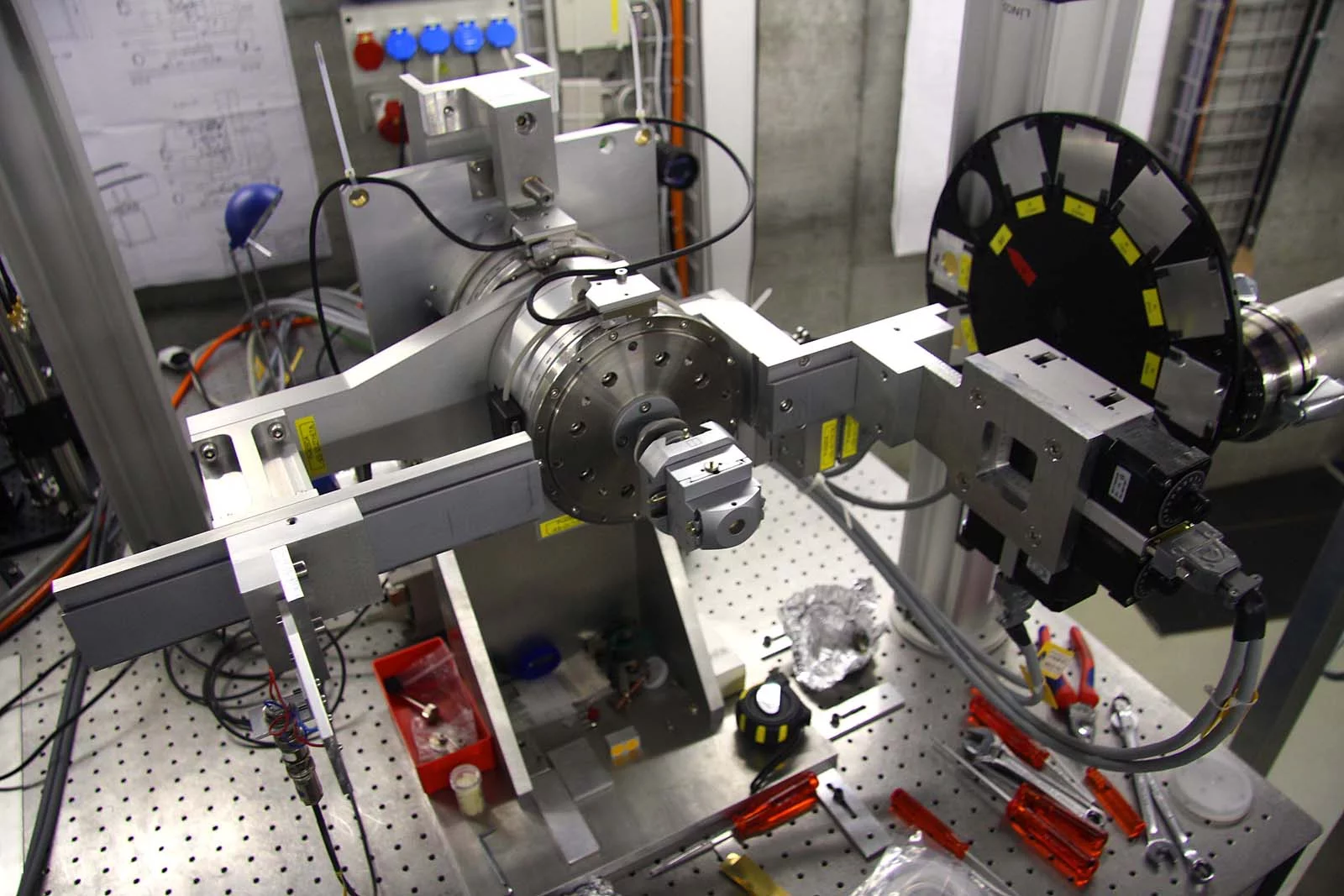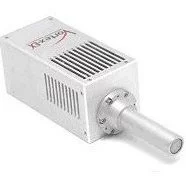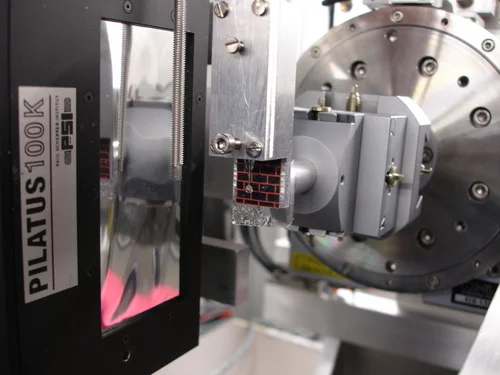JJ X-ray Slits
The slit system from JJ X-ray consists of 4 individual blades to define any rectangular apertur from zero up to 30 mm.
| Technical Specifications | |
|---|---|
| Apertur size | 30mm x 30mm (maximum, -20mm x -20mm (minimum) |
| Resolution | 1um in full step |
| Repeatability | +/- 1µm (uni-directional) |
| +/- 3µm (bi-directional) | |
| Accuracy | +/- 2µm (over 3mm) |
| Blades | Blade material Tungsten Carbide each blade is 2mm thick |
| Mechanical dimensions | 150mm x 150mm |
| 95mm x 95mm x 50mm (housing only) | |
| Weight | ~3kg |
| Motors | Stepper Motors Unipolar, 0.9deg step angle |
Filterwheel / Attenuator
Filterwheel from OWIS with the dimension 312.5 x 310 x 88 mm. It is possible to fix 12 unmounted filter-plates with the dimension of 50 x 50 mm or 12 mounted filters with the dimension diameter 45 mm.
| Technical Specifications | |
|---|---|
| Travel range | 360 deg |
| Motors | stepper motor, unipolar, 200 full steps/rev, 1.2 A |
Mounted Filters with Calculated Transmittance
| Mounted Filters | |||
|---|---|---|---|
| position | material | T(10 keV) | T(E) |
| 1 | air 1cm | 0.994 | T(E) |
| 2 | Al 0.2 mm | 0.262 | T(E) |
| 3 | Al 0.5 mm | 3.5E-2 | T(E) |
| 4 | Al 1.0 mm | 1.2E-3 | T(E) |
| 5 | Al 2.0 mm | 1.5E-6 | T(E) |
| 6 | Al 5.0 mm | 2.7E-15 | T(E) |
| 7 | Fe 29.0 μm | 2.0E-2 | T(E) |
| 8 | Cu 26.1 μm | 6.1E-3 | T(E) |
| 9 | Zn 103 μm | 2.5E-8 | T(E) |
| 10 | Mo 30.1 μm | 7.8E-2 | T(E) |
| 11 | Ag 26.5 μm | 4.1E-2 | T(E) |
| 12 | Au 20.5 μm | 1.0E-2 | T(E) |
Diffractometer Huber
The diffractometer (Two-Circle Goniometer 415) from Huber is a combination of two motorised 1-circle goniometers. Both circular motion are independent of each other. The upper circle is equipped with a 2-theta arm with a carriage. A further carriage is mounted on the side of the housing od the upper circle. Samples can be mounted on the goniometer head 1003 attached to the theta axis- it alows two angular adjustments, the center of rotation is at an elevation of 36 mm above the goniometer head. The height of the head itselfe is adjustable +/- a few mm.
| Technical Specifications | |
|---|---|
| Travel range | 360 deg (adjustable limit switches) |
| Resolution | 0.0001 deg i.e. ~1.75 µrad (20x micro stepping) |
| Motors | Stepper Motors, VEXTA PK566-BW, 5-Phase, step angle 0.72deg (500 steps/rev) |
| Encoder | Renishaw, accuracy to ±0.5 arcsec and resolution to 0.027 arcsec, reference signal, diameter: 150 mm, pitch: 20 µm, interpolation: 2000, resolution: 7.639437e-6 deg. |
Vortex Energy-Dispersive Detector
- The Vortex silicon drift detector module is an energy dispersive detector with a 25 mum Be window and built in peltier cooling.
- The system consists of the detector head, a special cable, 3 m long BNC plus sub-D, thee power supply and the Saturn DXP electronics from XIA.
- Working principle of the SDD (Silicon Drift Detector/Diode): Like other solid state X-ray detectors, silicon drift detectors measure the energy of an incoming photon by the amount of ionization it produces in the detector material. In the SDD, this material is high purity silicon with a very low leakage current. The high purity allows for the use of Peltier cooling instead of the traditional liquid nitrogen. The major distinguishing feature of an SDD is the transversal field generated by a series of ring electrodes that causes charge carriers to 'drift' to a small collection electrode. The 'drift' concept of the SDD (which was imported from particle physics) allows significantly higher count rates.
| Technical Specifications | |
|---|---|
| active area | 50 mm2 |
| energy range | 0.1 ... 30 keV |
| min. energy resolution | < 136 eV FWHM @ 5.9 keV and 12 µs peaking time |
| min. energy resolution | < 230 eV FWHM @ 5.9 keV and 0.25 µs peaking time |
| count rate | 0.6 MHz with 0.25 µs peaking time |
Pixel Detector EIGER
Since 2016 the beamline has an EIGER detector read out by the areaDetector software. Technical details.
Pixel Detector Pilatus 100 k
The Pilatus detector can be borrowed from the PSI detector group.
Technical Specifications
- max. count rate per pixel: 1e6/s
- pixel size: 172 x 172 µm (0.0296 mm2)
- 2 x 8 chips per module
- 487 * 195 = 94965 pixel
- (84 x 33.5) mm

